
When writing a guest blog post, generally you’ll have the opportunity to write a short author bio about yourself. Think of it as your personal elevator pitch. An elevator pitch is a 30-second memorable description of what you do and/or what you sell. You want to lead with your strongest attributes that are relevant to the audience. This is an important opportunity that you don’t want to overlook because it’s a major facet that supports your long-term content strategy plan.
Where to start?
First, follow the instructions given to you by your contact.
It’s possible the site you’re writing for will offer guidelines for your author bio. For example, your author bio could be up to 100 words, one link to your website, and a high-resolution headshot. Make sure to follow these instructions and use them as the baseline for creating your author bio.
Once you have confirmation on your guest post, make it a point to ask the person you’re working with for guest author bio guidelines. Doing so early on in the process will help reduce back and forth via email, making it easier and pleasant to work with you.
And second, research the format for other guest bloggers on their site.
An efficient way to get started with writing your author bio is to review several author bios on their site, preferably guest authors if you can find them.
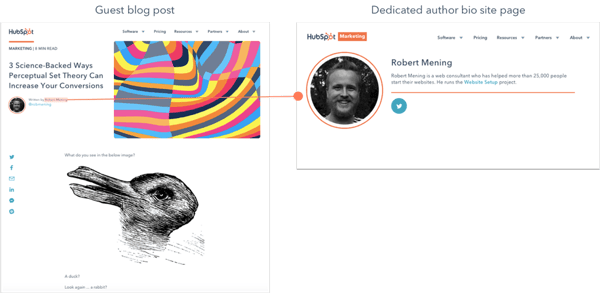
You can do this by navigating to a blog post on their site. The author bio will exist either on the actual blog post or can be accessed by clicking the author’s name, which will take you to their author bio on a dedicated page on the site.
Plus, reviewing other examples can help give you creative ideas on where to start when crafting one of your own.
However, it’s possible there may not be an order or consistency across author bios on the site. In this case you’ll have more creative freedom. Although, it still helps to have guardrails to ensure you’re being effective with your author bio.
Here are eight best practices to consider when writing an effective author bio. To help us visualize what this looks like in action, let’s dissect an author bio I use when writing guest blog posts for Content Marketing Institute as an example.
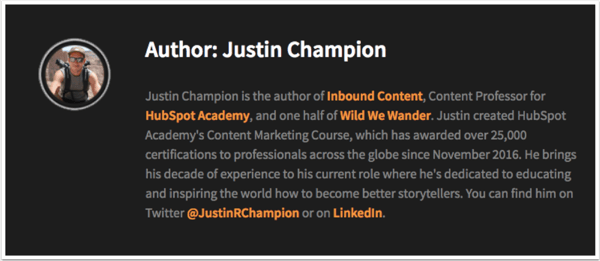
1. Tell them about yourself.
This should be personal and career focused. For example, in my author bio, I explain that:
-
I’m the Content Professor for HubSpot Academy; this is what I do for work.
-
I’m a published author of a book, Inbound Content, which is a relevant read for this audience.
-
And I’m one half of Wild We Wander, my alternative lifestyle brand.
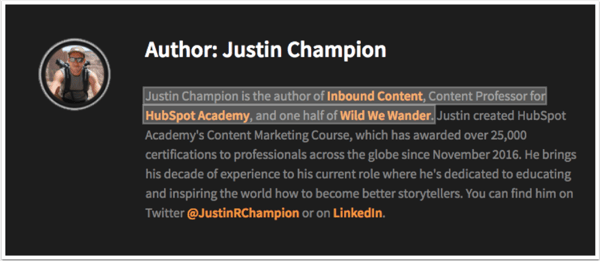
At a minimum, make sure to include your title and company you work for. Additionally, it’s best not to go over the top with jargon or buzzwords in your title, like if I called myself a Content Wizard as opposed to a Content Professor. Doing so could result in my audience rolling their eyes and me losing credibility with them.
Moreover, use acronyms sparingly. If you’re an SEO Director, then write Search Engine Optimization Director. If you’re a PPC analyst, then write Pay Per Click Analyst.
2. Choose a high-resolution photo of yourself.
Include a professional yet casual photo of yourself. Make sure it’s one where you’re smiling – you don’t want your photo to look like a mugshot.
I chose a high-resolution photo that’s true to me and my style.
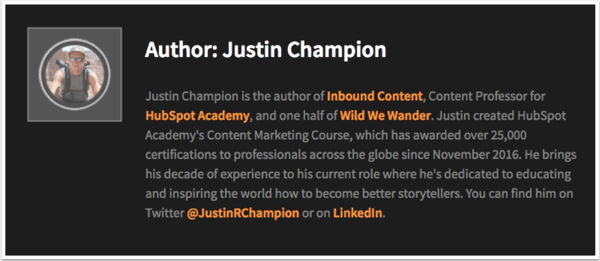
3. Keep it short and concise.
Make it a habit to write an author bio that’s 100 words or less. This is more than enough words to form an effective elevator pitch for yourself. It generally works out to be 3–5 sentences.
This example is 75 words and four sentences in length.
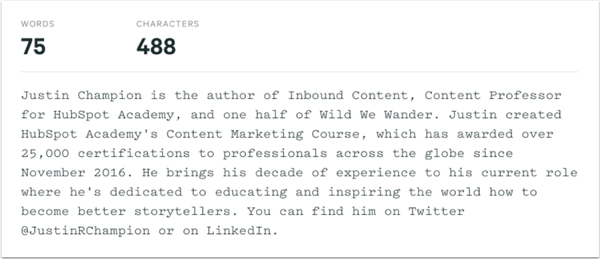
4. Explain what you do in the third person.
Your author bio should be written as if someone else were talking about you. Lead with your name as opposed to “I”.
Notice how I refer to myself as “Justin,” “he,” and “him” in my author bio.
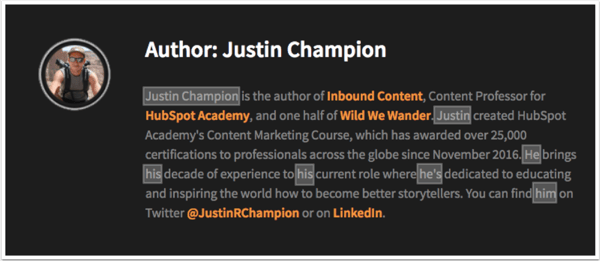
5. Include an element of validation.
You want your audience to see you as a credible source. In order to do this, you need to give them a reason to see you as a thought leader within the industry. You can do this by offering a performance stat or an award you received if it’s relevant.
For example, I chose to include that I’m the creator of HubSpot Academy’s Content Marketing Certification Course, which at the time had awarded over 25,000 certifications to professionals across the globe. This is something that can help me build credibility with my audience if they don’t know who I am yet.
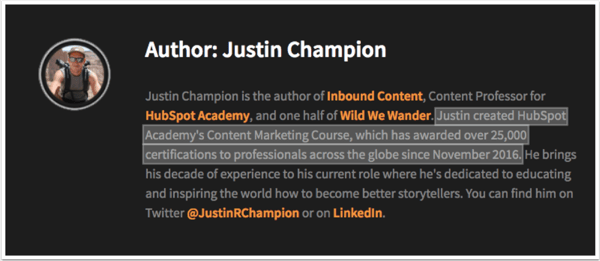
6. Provide something interesting or authentic about yourself.
Remember, we’re all human. Offer something personal about yourself that helps the reader better connect with you.
In this case, I led with my purpose. I’m dedicated to educating and inspiring the world how to become better storytellers.
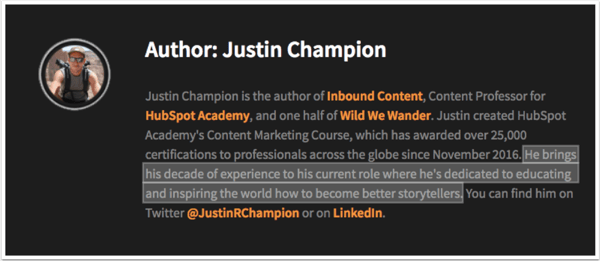
7. Offer social media channels where readers can engage with you.
Don’t list all your social channels — just list the top one to two channels where people can engage with you. Make sure the channels you choose are ones that you monitor and engage with people on regularly.
For me that’s Twitter and LinkedIn. Make sure to hyperlink the social channel in your description with your social profile link. This way people can easily find you by clicking the link.
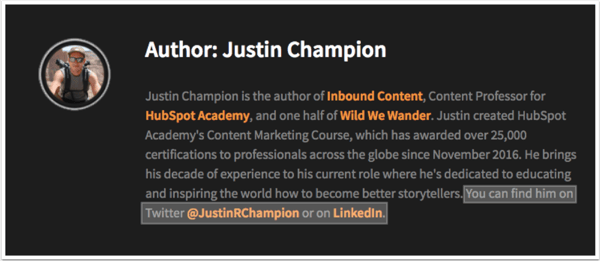
8. Include at least one inbound link to your website.
Remember, guest blogging is a great way to build inbound links back to your website. Some sites will only offer a link back to your website in the author bio, so it’s important to be strategic about your link choice.
When choosing which link or links to include in your author bio, here are a few things to consider:
-
Link to your website. At a minimum, link to your homepage. However, you could link to a specific site page if it’s educational and relevant to your article or audience.
-
And don’t link to a landing page. Doing so could result in the site removing your link altogether.
For example, I included a link in my author bio to Wild We Wander’s website as it’s helpful and relevant to my audience.
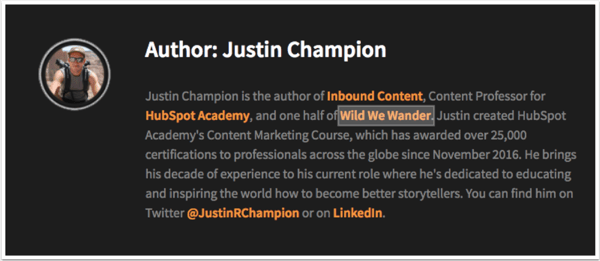
In the event you’re writing for a site that won’t allow you to link back to your website, don’t consider this a loss. This will happen. Focus on the opportunity you’re getting to educate and inspire a new audience. Do your best to create a meaningful experience. If you do, then people will come looking for more.
Justin Champion
Justin Champion is the author of Inbound Content, Principal Content Professor for HubSpot, Adjunct Lecturer for the University of Florida, and one half of Wild We Wander. Justin created HubSpot Academy's Content Marketing Course, which has awarded over 30,000 certifications to professionals across the globe since...





